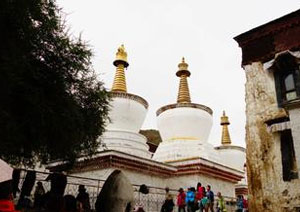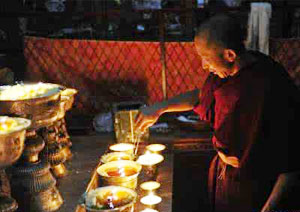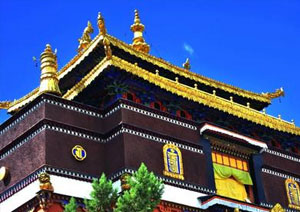 Sakya Monastery, 160 kilometers west of Xigaze, is composed of the Southern and the Northern Monasteries. The Northern Monastery was built in 1097 and the Southern Monastery in 1268. The Southern Monastery houses large numbers of cultural relics including the titles, seals, crowns, garments and ornaments awarded by the Yuan Sakya Monastery's Imperial Court to local officials. Statues of Buddha, ritual instruments, precious murals of historical themes and porcelains come from the Song, Yuan and other later dynasties. The monastery has preserved great numbers of books such as the Bakgyur, Bstanggyur, Pattra-leaf scripture, and other Tibetan classics on astronomy, geography, history, medicine and literature.
Sakya Monastery, 160 kilometers west of Xigaze, is composed of the Southern and the Northern Monasteries. The Northern Monastery was built in 1097 and the Southern Monastery in 1268. The Southern Monastery houses large numbers of cultural relics including the titles, seals, crowns, garments and ornaments awarded by the Yuan Sakya Monastery's Imperial Court to local officials. Statues of Buddha, ritual instruments, precious murals of historical themes and porcelains come from the Song, Yuan and other later dynasties. The monastery has preserved great numbers of books such as the Bakgyur, Bstanggyur, Pattra-leaf scripture, and other Tibetan classics on astronomy, geography, history, medicine and literature.
 Shalu Monastery is located 20 kilometers southeast of Xigaze. It was first built in 1087. It is famous for its sandalwood slips carved with Buddhist scripture and a jar used to hold sacred water, in which, it is said, the water does not decrease or deteriorate. The murals in the monastery are an example of excellent workmanship and are one of the rare fine arts in Tibet. Legend has it that Jigzun Xerab Qoinnyai asked for advice from his teacher Lhodain Dorje Wangqug on the selection of the site for a monastery. The latter hurled his staff, as if shooting an arrow and the staff fell where the site of the monastery was established. The staff fell on the tender leaves of canola plants; thus came the name of Xalhu, meaning new growth of tender leaves.
Shalu Monastery is located 20 kilometers southeast of Xigaze. It was first built in 1087. It is famous for its sandalwood slips carved with Buddhist scripture and a jar used to hold sacred water, in which, it is said, the water does not decrease or deteriorate. The murals in the monastery are an example of excellent workmanship and are one of the rare fine arts in Tibet. Legend has it that Jigzun Xerab Qoinnyai asked for advice from his teacher Lhodain Dorje Wangqug on the selection of the site for a monastery. The latter hurled his staff, as if shooting an arrow and the staff fell where the site of the monastery was established. The staff fell on the tender leaves of canola plants; thus came the name of Xalhu, meaning new growth of tender leaves.
 Built in 1447, the Tashilhungpo (meaning auspicious Sumeru) Monastery is located on the southern slope of the Nyima Mountain to the west of the Shigatze. It is one of the four monasteries of the Gelug Sect of Tibetan Buddhism. According to historical documents, the monastery was built under the supervision of the first Dalai Lama, Genden Zhuba, a disciple of Zongkapa, the founder of the Yellow Sect. When the fourth Panchen Lobsan Qoigyi became the abbot, it was expanded to a large scale. Since then, the monastery has become the residence of Panchen Lama. Listed as a key relic under state protection by the State Council on March 4, 1961, the monastery occupies 150,000 square meters. Facing south, the complex is built symmetrically against the Nyima Mountain. Its wall, over 3,000 meters long and built according to the topography of the mountain, surrounds 57 buildings, and more than 3,600 rooms…
Built in 1447, the Tashilhungpo (meaning auspicious Sumeru) Monastery is located on the southern slope of the Nyima Mountain to the west of the Shigatze. It is one of the four monasteries of the Gelug Sect of Tibetan Buddhism. According to historical documents, the monastery was built under the supervision of the first Dalai Lama, Genden Zhuba, a disciple of Zongkapa, the founder of the Yellow Sect. When the fourth Panchen Lobsan Qoigyi became the abbot, it was expanded to a large scale. Since then, the monastery has become the residence of Panchen Lama. Listed as a key relic under state protection by the State Council on March 4, 1961, the monastery occupies 150,000 square meters. Facing south, the complex is built symmetrically against the Nyima Mountain. Its wall, over 3,000 meters long and built according to the topography of the mountain, surrounds 57 buildings, and more than 3,600 rooms…
| Shigatze Attractions List |

